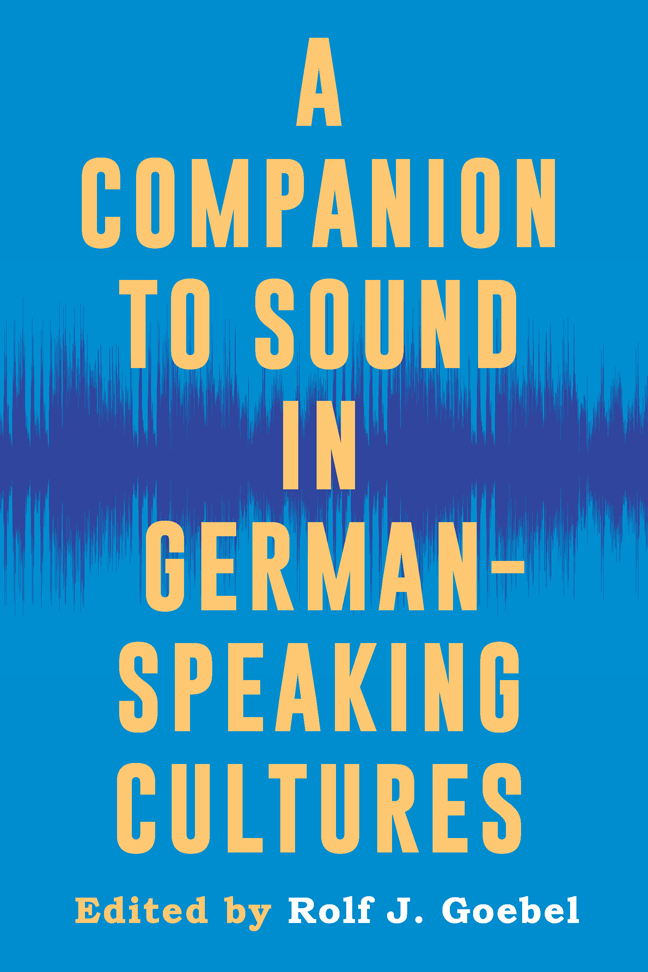Book contents
- Frontmatter
- Contents
- List of Illustrations
- Preface
- Introduction
- Part I Sonic Practices from the Middle Ages to the Nineteenth Century
- Part II Rediscovering the Sounds of Modernism
- Part III Listening to the Unbearable: The Sounds of National Socialism and the Holocaust
- Part IV After the Catastrophe: Sounds in Postwar Germany and Beyond
- Part V Sounds of the Present
- Part VI Epilogue
- Select Bibliography and Further Reading
- Notes on the Contributors
- Index
14 - Carsten Nicolai's Art of Disturbance: Sound, Science, and Interference
Published online by Cambridge University Press: 21 February 2024
- Frontmatter
- Contents
- List of Illustrations
- Preface
- Introduction
- Part I Sonic Practices from the Middle Ages to the Nineteenth Century
- Part II Rediscovering the Sounds of Modernism
- Part III Listening to the Unbearable: The Sounds of National Socialism and the Holocaust
- Part IV After the Catastrophe: Sounds in Postwar Germany and Beyond
- Part V Sounds of the Present
- Part VI Epilogue
- Select Bibliography and Further Reading
- Notes on the Contributors
- Index
Summary
I. Introduction
The Work Of nineteenth-century physicist and physician Hermann von Helmholtz (1821–94) continues to tower over contemporary understandings of sound and acoustical perception. In its effort to uncouple the investigation of auditory phenomena from traditional strategies of visualization, from subjecting acoustics to the paradigm of the visual, Helmholtz's research played a key role in defining sound and its sensation on its own terms. Rather than wanting to observe objects meant to visualize acoustical vibrations, like Ernst Florens Friedrich Chladni during the late eighteenth century, Helmholtz's aim was to investigate the ear and its operations as an independent medium of aural experience and the acoustical as an autonomous field of knowledge. He thus advanced the differentiation of both scientific inquiry and human registers of sensory perception that are often seen as decisive hallmarks of what we have come to call the modern age. As importantly, Helmholtz's writing on the physics of sound waves, of reverberation and resonance, set up a new framework in which sound could be rethought as inherently relational: as something that belonged exclusively to neither a vibrating object nor a perceiving listener, but materialized and unfolded in the space in between them. Sound needed pulsating matter and receptive subjects to come into being, yet in doing so it also defined and shaped both as interdependent elements of the acoustical field in the first place.
Though champions of musical modernism or experimental sound art will unlikely follow this path of thought, Helmholtz also remains influential as a scientist eager to ground musical aesthetics—judgments about the quality, beauty, and pleasure of musical material—in empirical and hence measurable, perhaps even computational, observations and arguments. He not only explained dissonance as a result of acoustic “beats” caused by the interference of adjacent frequencies and consonance as the absence of such beats, but in his assessment of “good” music he sought to reconcile the tensions in classical aesthetic discourses between choice and necessity, freedom and causation. According to Helmholtz, the modern major scale sounded pleasurable to the (Western) ear because listeners had learned to embrace (Western) tonality as “the necessary consequence, conditioned by the nature of things, of the chosen stylistic principle.” To put it crudely: good style and music, in Helmholtz's view, required composers and listeners willing to accept and put to work what nature prescribed and scientists could objectively describe.
- Type
- Chapter
- Information
- A Companion to Sound in German-Speaking Cultures , pp. 227 - 242Publisher: Boydell & BrewerPrint publication year: 2023

